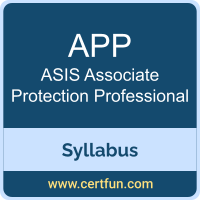 Use this quick start guide to collect all the information about ASIS APP Certification exam. This study guide provides a list of objectives and resources that will help you prepare for items on the ASIS Associate Protection Professional (APP) exam. The Sample Questions will help you identify the type and difficulty level of the questions and the Practice Exams will make you familiar with the format and environment of an exam. You should refer this guide carefully before attempting your actual ASIS Associate Protection Professional (APP) certification exam.
Use this quick start guide to collect all the information about ASIS APP Certification exam. This study guide provides a list of objectives and resources that will help you prepare for items on the ASIS Associate Protection Professional (APP) exam. The Sample Questions will help you identify the type and difficulty level of the questions and the Practice Exams will make you familiar with the format and environment of an exam. You should refer this guide carefully before attempting your actual ASIS Associate Protection Professional (APP) certification exam.
The ASIS APP certification is mainly targeted to those candidates who want to build their career in Security Management domain. The ASIS Associate Protection Professional (APP) exam verifies that the candidate possesses the fundamental knowledge and proven skills in the area of ASIS APP.
ASIS APP Exam Summary:
| Exam Name | ASIS Associate Protection Professional (APP) |
| Exam Code | APP |
| Exam Price |
ASIS Members: $300 Nonmembers: $620 |
| Duration | 120 mins |
| Number of Questions | 125 |
| Passing Score | 80% |
| Schedule Exam | ASIS |
| Sample Questions | ASIS APP Sample Questions |
| Practice Exam | ASIS APP Certification Practice Exam |
ASIS APP Exam Syllabus Topics:
| Topic | Details |
|---|---|
Security Fundamentals (35%) |
|
| Implement and coordinate the organization’s security program(s) to protect the organization’s assets |
Knowledge of:
|
| Implement methods to improve the security program on a continuous basis through the use of auditing, review, and assessment |
Knowledge of:
|
| Develop and coordinate external relations programs with public sector law enforcement or other external organizations to achieve security objectives |
Knowledge of:
|
| Develop, implement, and coordinate employee security awareness programs |
Knowledge of:
|
| Implement and/or coordinate an investigative program |
Knowledge of:
|
| Provide coordination, assistance, and evidence such as documentation and testimony to support legal proceedings |
Knowledge of:
|
| Conduct background investigations for hiring, promotion, and/or retention of individuals |
Knowledge of:
|
| Develop, implement, coordinate, and evaluate policies, procedures, programs, and methods to protect individuals in the workplace against human threats (e.g., harassment, violence) |
Knowledge of:
|
| Conduct and/or coordinate an executive/personnel protection program |
Knowledge of:
|
| Develop and/or maintain a physical security program for an organizational asset |
Knowledge of:
|
| Recommend, implement, and coordinate physical security controls to mitigate security risks |
Knowledge of:
|
| Evaluate and integrate technology into security program to meet organizational goals |
Knowledge of:
|
| Coordinate and implement security policies that contribute to an information security program |
Knowledge of:
|
Business Operations (22%) |
|
| Propose budgets and implement financial controls to ensure fiscal responsibility |
Knowledge of:
|
| Implement security policies, procedures, plans, and directives to achieve organizational objectives |
Knowledge of:
|
| Develop procedures/techniques to measure and improve departmental productivity |
Knowledge of:
|
| Develop, implement, and coordinate security staffing processes and personnel development programs in order to achieve organizational objectives |
Knowledge of:
|
| Monitor and ensure a sound ethical culture in accordance with regulatory requirements and organizational objectives |
Knowledge of:
|
| Provide advice and assistance in developing key performance indicators and negotiate contractual terms for security vendors/suppliers |
Knowledge of:
|
Risk Management (25%) |
|
| Conduct initial and ongoing risk assessment processes |
Knowledge of:
|
| Assess and prioritize threats to address potential consequences of incidents |
Knowledge of:
|
| Prepare, plan, and communicate how the organization will identify, classify, and address risks |
Knowledge of:
|
| Implement and/or coordinate recommended countermeasures for new risk treatment strategies |
Knowledge of:
|
| Establish a business continuity or continuity of operations plan (COOP) |
Knowledge of:
|
| Ensure pre-incident resource planning (e.g., mutual aid agreements, table-top exercises) |
Knowledge of:
|
Response Management (18%) |
|
| Respond to and manage an incident using best practices |
Knowledge of:
|
| Coordinate the recovery and resumption of operations following an incident |
Knowledge of:
|
| Conduct a post-incident review |
Knowledge of:
|
| Implement contingency plans for common types of incidents (e.g., bomb threat, active shooter, natural disasters) |
Knowledge of:
|
| Identify vulnerabilities and coordinate additional countermeasures for an asset in a degraded state following an incident |
Knowledge of:
|
| Assess and prioritize threats to mitigate consequences of incidents |
Knowledge of:
|
| Coordinate and assist with evidence collection for post-incident review (e.g., documentation, testimony) |
Knowledge of:
|
| Coordinate with emergency services during incident response |
Knowledge of:
|
| Monitor the response effectiveness to incident(s) |
Knowledge of:
|
| Communicate regular status updates to leadership and other key stakeholders throughout incident |
Knowledge of:
|
| Monitor and audit the plan of how the organization will respond to incidents |
Knowledge of:
|
To ensure success in ASIS APP certification exam, we recommend authorized training course, practice test and hands-on experience to prepare for ASIS Associate Protection Professional (APP) exam.
